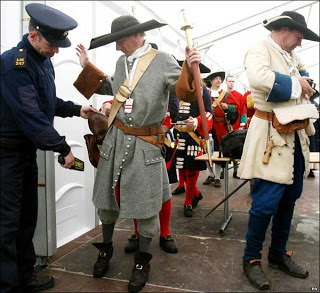In addition, there was also the chance to fight small/quick battles which would contribute to the fiction of the 'Three Kings in Albion' idea that I had mentioned many posts ago - with obvious parallels to the 'War of the Three Kings' and the Monmouth Rebellion in the actual 1680s and 90s.
'You're not going out there with those shoes on mate!'
Highlights from these rules.
- Activation is based on unit type and 2d6. You might want to activate the best units first as they have an easier roll, though that intent becomes more difficult when you have to protect that flank or get a shot in, and command decision takes over. There is real drama here. Although the system seems akin to Black Powder, it works much more smoothly. Rather than brigade activation kicking you in the ass, individual units and initiative switchover seems to be smoother and makes more sense in the narrative of the fight.
- Units are closely based on period types - pikes, shot, gallopers etc (some more akin to ECW and 30YW than others, but no great problem).
- There is real urgency to initiative changeover. When your opponent takes it and holds it, it can really hurt.
- With 2d6 activation, there is also 12d6/6d6 rolls for attacks and shooting. You get used to this after a while, and the 'stamina' value which dictates hits is quite inspired. I normally hate rolling buckets of d6, but this was ok.
- I love the morale system. It becomes intuitive quite quickly when a roll is required - hits etc., and as hits take a toll on the unit's chance of rolling enough to sustain the fight, it can get quite nailbiting. In essence, you can expect a unit to make 2 or 3 rolls before things start to go wrong - although there is always a chance it might rout earlier than you thought. This really has some great period flavour, especially with pike.
- Movement is simple. If I were to make changes, I might consider firing arcs/flanking, and maybe some movable leader influence for larger battles, but these are minor points.
- These would really work well for multi-player games - especially so where you have a mini campaign. Leaders grow with experience and gain more useful traits, just like a role playing game (but without the b.s.).
All in all a great set of rules...and you know, it makes the modern interpretation that Old Trousers has done over at 'Numbers, Wargaming & Arsing About' all the more plausible - where unit types and traits can use almost exactly the same system for a great game.
'He's gone down to the pub again, hasn't he? *sigh* '
McCarty's B'stards move from the pub.
Cavalry charges on McGelliot's left flank go in early...
They're repulsed, but at significant cost to McCarty's shot units.
Long range shooting from McGelliot is uncannily accurate...with no definite response.
'There's just, too much, cotton wool *cough*.'
But McCarty's seasoned pike turns on the horse...
...to deadly effect, as the cavalry disperses. As stated - two or three morale rolls, and you really get the impression of units melting away due to casualties. This works at a larger scale, and there's no reason why pike/shot units integrated as single battalions couldn't be represented for larger battles - perhaps with better defence vs cavalry if pike get a chance to form etc.
Buoyed up by their success however, they charge to their doom at the hands of McGelliot's forlorn hope, but it's a disastrous last gasp, as the pike get shot away.
With one unit remaining, the Eryn general has no choice but to flee.
'Run McCarty, run you fool! I'll find you...(just as soon as I get some eye liner on)!'
'Ha...he's defeated me this time, but I'll have the last laugh. He'll buy me a pint or DIE at my hands, damn his eyes!!! This isn't over, not by a long shot...d'ye hear?'
(Ok, I promise not to take the p*ss out of the17th century next time...)
It is said that the war in Albion started with a tavern
brawl in mainland Europe. Of course, we consider such trivial reasons for war
as somewhat circumspect these days, though it is worth considering the lore
surrounding the skirmish at the Siege of
Lennes in 1672.
Apparently bored with the action (or lack of it) concerned
with the digging of the lines of circumvallation during the investment of the
European city, two factions, fighting under the Frankish flag in capacity as
both Eryn mercenary and at the English King’s pleasure, broke down into
fighting. It is said to this day that Roger McGelliot’s refusal to buy Justyn
McCarty a pint of beer started the fracas, which developed into a brawl, which
in turn developed into a rapid drawing of battle lines in the fields north of the
city. By the time their superiors had determined just what was going on, it was
too late, and the first shots of what would degenerate into a new English civil
war (albeit started upon the fields of Frankreich), had been fired…
Today we call the eventual campaign that took place on the
Albion mainland a religious war, though it is tempting to think that the whole
thing may in fact have started, over a pint…
Geoffrey Pebbledash – The History of Albion











































